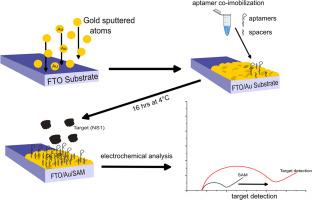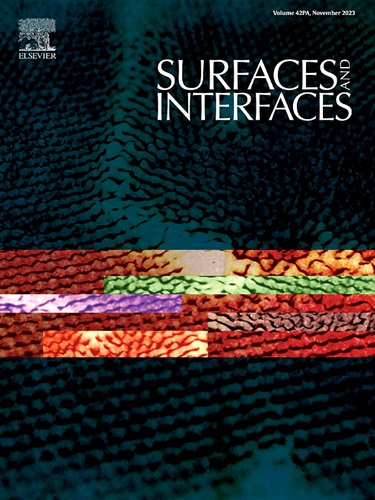用于高灵敏度登革热检测的金增强型适配体:一种具有成本效益的方法
IF 6.3
2区 材料科学
Q2 CHEMISTRY, PHYSICAL
引用次数: 0
摘要
登革热等疾病的再次出现推动了高效生物传感设备的发展。本研究旨在建立一个快速、经济、高效的登革热检测平台。传感器的表面是通过在玻璃基底上沉积的掺氟氧化锡薄膜上溅射金而形成的。使用了不同的溅射沉积时间。X 射线衍射分析结果表明,沉积时间为 4 分钟的薄膜具有最佳的金表面覆盖率和最佳的传感器制造成本效益比。随后,对金薄膜进行了功能化处理,共同固定了一个由aptamers和6-巯基-1-己醇(MCH)组成的自组织单层。利用电化学阻抗光谱技术对单层进行了分析,并确定了 1:25(灵敏剂:总硫醇)的表面优化比例。在检测登革热血清型 4 的非结构蛋白 1(NS1-S4)时测试了该适配体的性能。结果表明,灵敏度为 40.2 ± 3.7 %/10,检测限低至 1.25 pg/mL。该平台的开发标志着用于检测登革热等新兴疾病的快速灵敏传感器制造技术的进步,同时也促进了护理点设备的微型化进程。本文章由计算机程序翻译,如有差异,请以英文原文为准。

Gold-enhanced aptasensors for highly sensitive dengue detection: a cost-effective approach
The reemergence of diseases such as Dengue has spurred the development of efficient biosensing devices. This study aims to establish a rapid, cost-effective, and efficient platform for Dengue detection. The surface of the sensor was constructed by sputtering gold onto fluorine-doped tin oxide thin films, that were previously deposited on glass substrates. Varied sputtering deposition times were used. Results obtained from X-Ray Diffraction analysis showed that the films with 4-minute deposition time had the best gold surface coverage and the best cost-benefit ratio for sensor fabrication. Subsequently, the gold thin films were functionalized with the co-immobilization of a self-organized monolayer of aptamers and 6-mercapto-1-hexanol (MCH). The monolayer was analysed using the electrochemical impedance spectroscopy technique, and the ratio of 1:25 (aptamer: total thiol) was determined for surface optimization. The performance of the aptasensor was tested for the detection of the non-structural protein 1 of Dengue serotype 4 (NS1-S4). A good sensitivity of 40.2 ± 3.7 % per decade and a low detection limit of 1.25 pg/mL were obtained. The development of this platform represents an advance in the fast fabrication of aptasensors for the detection of emerging diseases such as Dengue, contributing also to the miniaturization process of point-of-care devices.
求助全文
通过发布文献求助,成功后即可免费获取论文全文。
去求助
来源期刊

Surfaces and Interfaces
Chemistry-General Chemistry
CiteScore
8.50
自引率
6.50%
发文量
753
审稿时长
35 days
期刊介绍:
The aim of the journal is to provide a respectful outlet for ''sound science'' papers in all research areas on surfaces and interfaces. We define sound science papers as papers that describe new and well-executed research, but that do not necessarily provide brand new insights or are merely a description of research results.
Surfaces and Interfaces publishes research papers in all fields of surface science which may not always find the right home on first submission to our Elsevier sister journals (Applied Surface, Surface and Coatings Technology, Thin Solid Films)
 求助内容:
求助内容: 应助结果提醒方式:
应助结果提醒方式:


